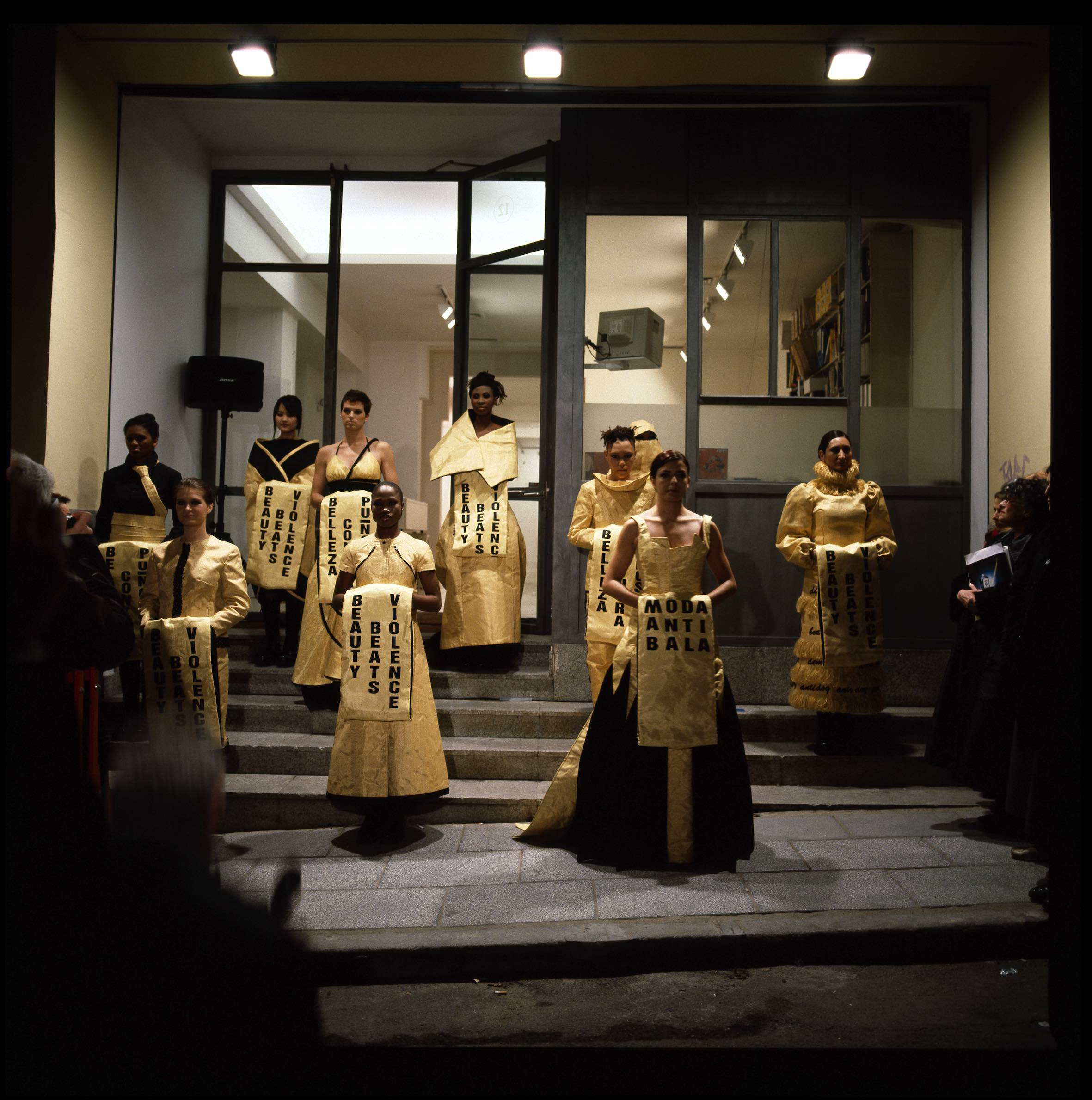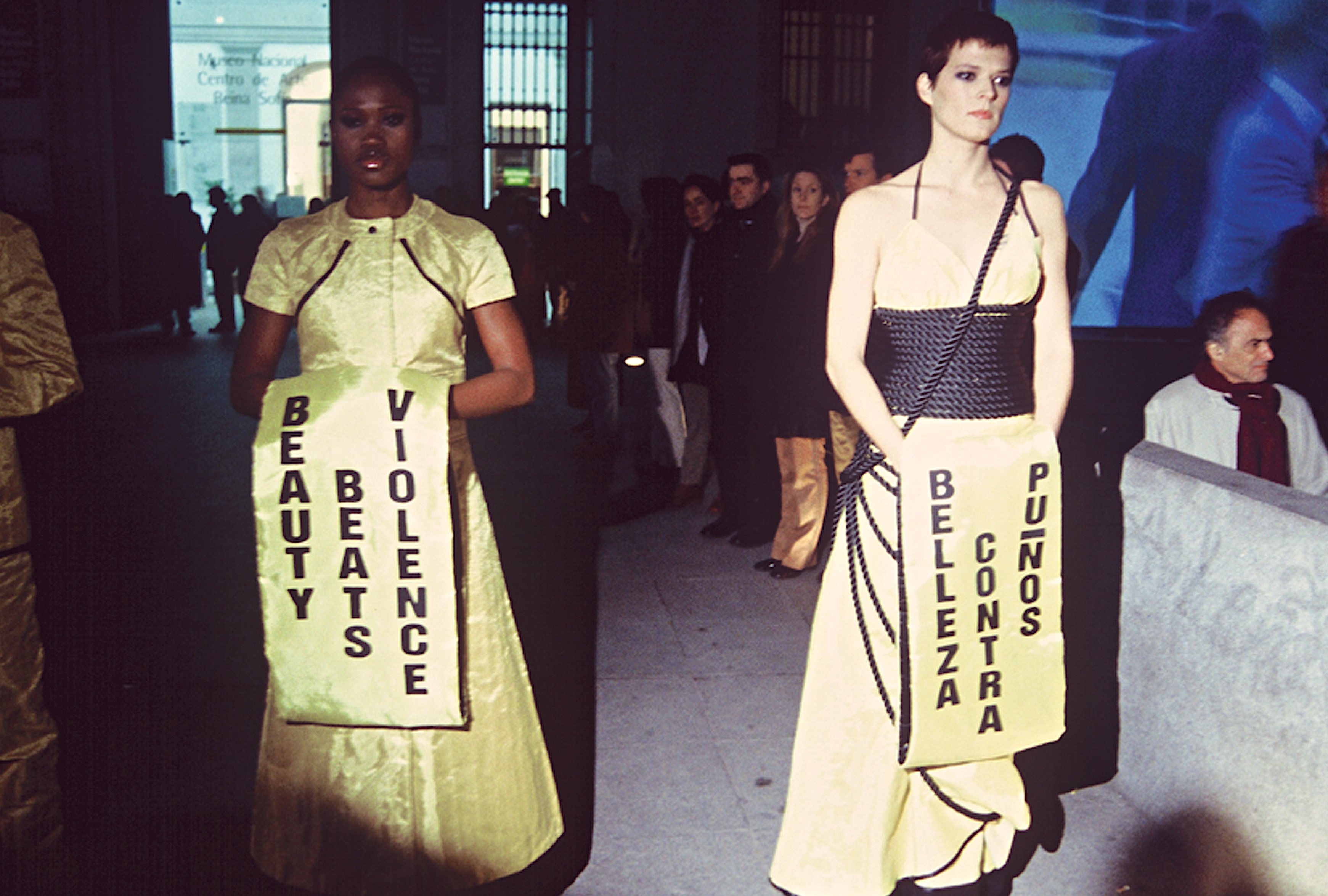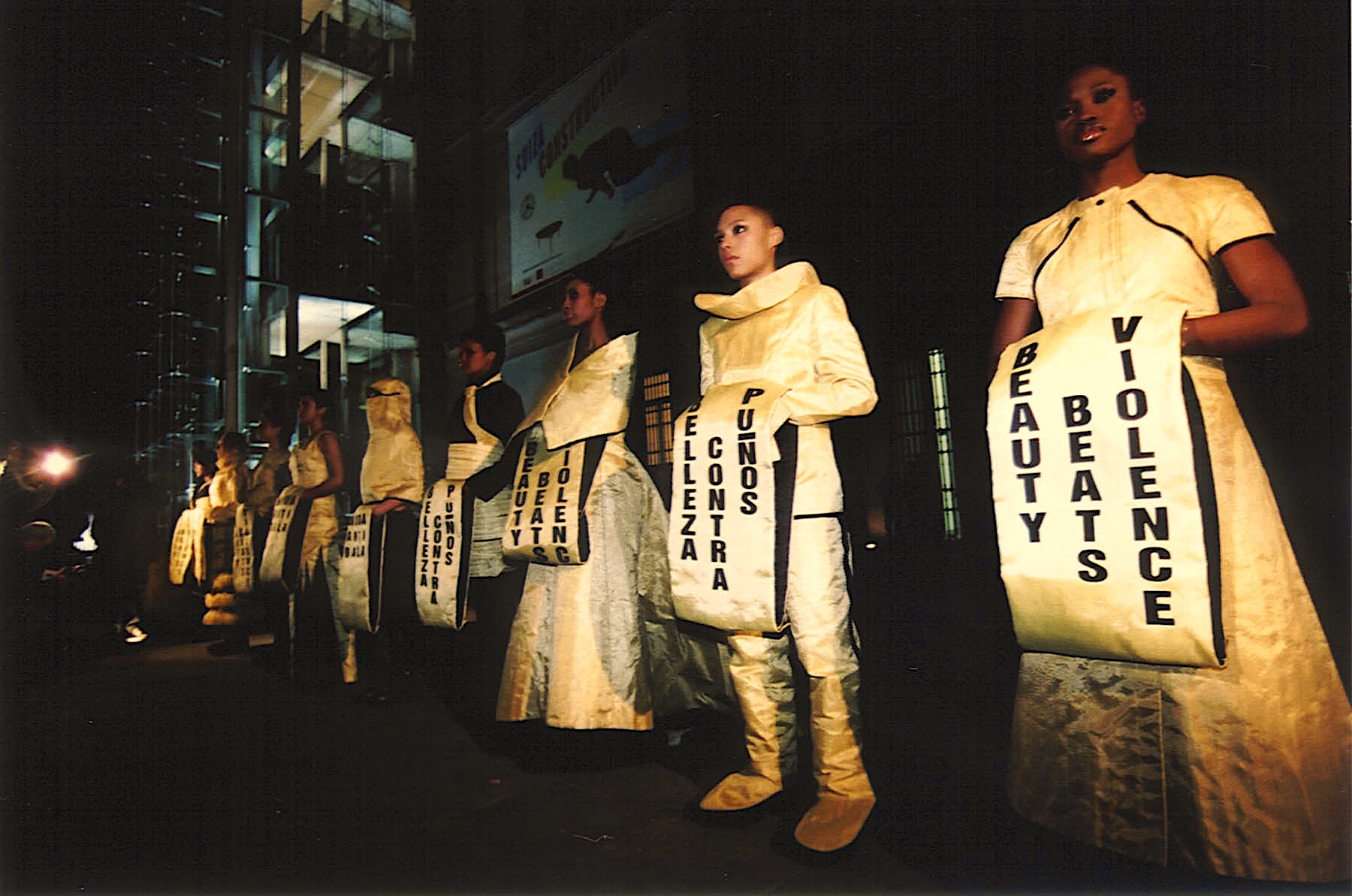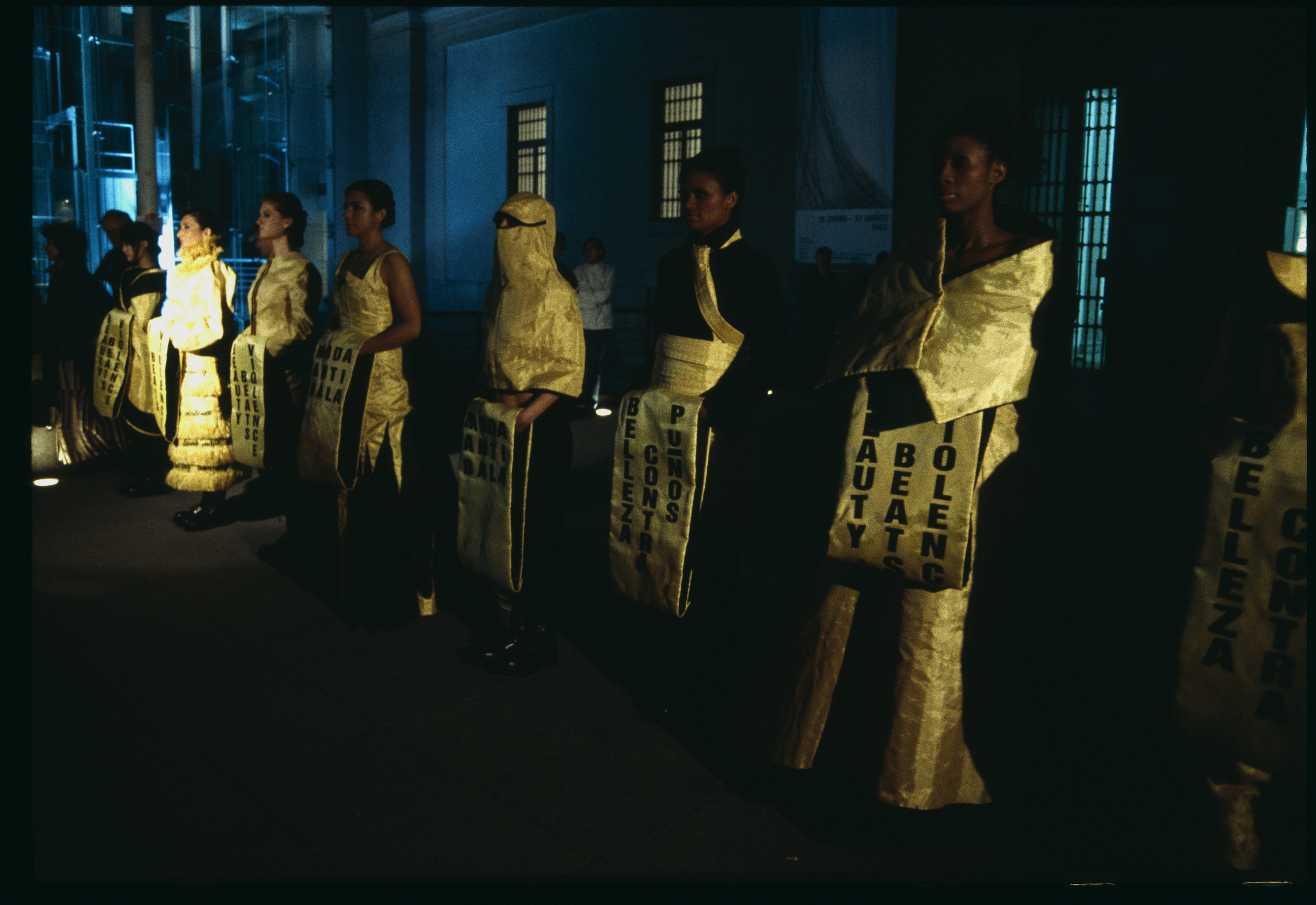Madrid , 2002
ANTI_DOG
Performance, 2000 – 2003, demonstrations in Paris, Amsterdam, Madrid, Birmingham, Helsinborg, Barcelona, and Venice. Included in the Dutch Pavilion at the 2003 Venice Biennale. Dresses made from a dog bite-proof, fire-proof and bullet-proof fabric
ANTI_DOG AGAINST DOMESTIC VIOLENCE
Madrid 2003
In Spain, 27 women were killed in their homes between January 1st and May 1st. This situation made me decide to stage a demonstration against domestic violence in Madrid.
The anti_dog brand was introduced to make women, especially women of color, feel protected in dangerous neighborhoods, against skinheads with their dogs and other aggressors.
This project started with Framis’s experiences while she was living in Berlin. She was told about a certain city quarter called Marzahn, where a woman with dark skin would not be able to walk alone because racist skinheads with big aggressive dogs ruled the streets there. She felt the urge to go, but with some form of protection against the dogs.
‘Immigrant women talk about these matters secretly because we feel ashamed to be an undesirable immigrant,’ Alicia Framis explains. ‘On the other hand, we are immensely grateful to have the opportunity to develop ourselves in the other country. Where we live is not our soil by nature, but we feel more connected to our dreams than the country we one day left. I feel ashamed to denounce physical and psychological attacks from people that I embrace as inhabitants of my land of dreams and possibilities, but at the same time, it is a reality that is there in the shades of our politeness.
‘Nowadays “safety” and “protection” are high on the agenda of politicians and citizens, but the means they use to achieve this are scary. Omnipresent video cameras should protect us against other people, but instead, they deprive us of our intimacy. The loss of intimacy reinforces the idea of insecurity and a lack of safety. Video cameras are a closed circuit: fear—watch—no intimacy—fear—watch—no intimacy—fear—watch—no intimacy. Protection doesn’t come from a monitor; the monitor is just a witness to our fear. Safety comes from the feeling that you are the owner of your own body and mind.’.
BEAUTY BEATS VIOLENCE
With the introduction of the anti_dog fashion label, Alicia Framis was addressing topics like safety, vulnerability, racism and violence, which were high on the global political and cultural agenda, in a highly refreshing way.
After extensive research, she and her team found the fabric suitable for creating her garments. The Dutch invention Twaron was a revolution in the world of protection and reinforcement. Five times stronger and significantly lighter than steel, it is often used for bullet- and stab-resistant vests. The glossy, gold-like color of the fiber gave it the allure that Framis wanted for her dresses.
The garments created with Twaron were worn by women of mixed races at demonstrations in several European cities that have a reputation for aggression against women (of color). For each city, the collection was enlarged with special designs for the specific situation, in close collaboration with the host organization. For example, in Helsingborg, Sweden, a group of women was fighting for better lighting at dangerous dark spots in the city, such as creepy alleys. Framis worked with these women and local designers to invent dresses that emit light and make the women visible.
In Paris, a collection largely inspired by famous designers such as Courrèges, Christian Dior, and Coco Chanel was shown, with an ironic wink, on a catwalk during Paris Fashion Week. With the huge skirts designed for Birmingham, the women occupied an entire public square. Because the sentences written on the skirts (such as ‘This is not your Country’) are copyrighted, they can never be used in public again without risking a fine.
After Paris, Amsterdam, Madrid, Helsingborg, Barcelona and Birmingham, the collection consisted of 23 garments with their accessories. In Venice, they were all shown together for the first time in the anti_dog fitting room.
This ‘dome’ could be closed and became a fully protected shelter constructed with five of the anti_dog dresses.
This work draws our attention to three important issues. First, it points out the uselessness of the road we have taken to actually protect ourselves. For the sake of protection, there is a huge network of cameras installed in public as well as private spaces, which creates either the uncomfortable feeling of Big Brother or the awareness that there will never be enough people to actually watch all that footage, let alone be in time to act upon it if necessary. In conjunction with this proliferation of cameras, we tend to lock ourselves within high fences, creating our own prisons. To counteract this tendency, Framis’s fashion suggests optimum individual freedom as well as literal and figurative visibility.
Secondly, the work makes us aware of the way we usually protest against violence and racism. It seems as if the aesthetics of demonstrations have remained unchanged since the very first time a group of people marched in the streets to proclaim their disagreement. Framis makes the protest seductive and powerful at the same time.
Finally, and perhaps most importantly, Framis placed the combined themes of racism and violence against women on the agenda, at a time when it seemed that feminism was retreating into the shadows in the Western world.
The anti_dog demonstration magazine En Garde was an insert in N°C M agazine, which was guest-edited by Hussein Chalayan and published by Artimo.
Text by Lilet Breddels, adapted from We Are The World, the catalog for the Dutch Pavilion at the 2003 Venice Biennale.




ANTI_DOG AGAINST DOMESTIC VIOLENCE
Madrid 2003
In Spain, 27 women were killed in their homes between January 1st and May 1st. This situation made me decide to stage a demonstration against domestic violence in Madrid.
The anti_dog brand was introduced to make women, especially women of color, feel protected in dangerous neighborhoods, against skinheads with their dogs and other aggressors.
This project started with Framis’s experiences while she was living in Berlin. She was told about a certain city quarter called Marzahn, where a woman with dark skin would not be able to walk alone because racist skinheads with big aggressive dogs ruled the streets there. She felt the urge to go, but with some form of protection against the dogs.
‘Immigrant women talk about these matters secretly because we feel ashamed to be an undesirable immigrant,’ Alicia Framis explains. ‘On the other hand, we are immensely grateful to have the opportunity to develop ourselves in the other country. Where we live is not our soil by nature, but we feel more connected to our dreams than the country we one day left. I feel ashamed to denounce physical and psychological attacks from people that I embrace as inhabitants of my land of dreams and possibilities, but at the same time, it is a reality that is there in the shades of our politeness.
‘Nowadays “safety” and “protection” are high on the agenda of politicians and citizens, but the means they use to achieve this are scary. Omnipresent video cameras should protect us against other people, but instead, they deprive us of our intimacy. The loss of intimacy reinforces the idea of insecurity and a lack of safety. Video cameras are a closed circuit: fear—watch—no intimacy—fear—watch—no intimacy—fear—watch—no intimacy. Protection doesn’t come from a monitor; the monitor is just a witness to our fear. Safety comes from the feeling that you are the owner of your own body and mind.’.
BEAUTY BEATS VIOLENCE
With the introduction of the anti_dog fashion label, Alicia Framis was addressing topics like safety, vulnerability, racism and violence, which were high on the global political and cultural agenda, in a highly refreshing way.
After extensive research, she and her team found the fabric suitable for creating her garments. The Dutch invention Twaron was a revolution in the world of protection and reinforcement. Five times stronger and significantly lighter than steel, it is often used for bullet- and stab-resistant vests. The glossy, gold-like color of the fiber gave it the allure that Framis wanted for her dresses.
The garments created with Twaron were worn by women of mixed races at demonstrations in several European cities that have a reputation for aggression against women (of color). For each city, the collection was enlarged with special designs for the specific situation, in close collaboration with the host organization. For example, in Helsingborg, Sweden, a group of women was fighting for better lighting at dangerous dark spots in the city, such as creepy alleys. Framis worked with these women and local designers to invent dresses that emit light and make the women visible.
In Paris, a collection largely inspired by famous designers such as Courrèges, Christian Dior, and Coco Chanel was shown, with an ironic wink, on a catwalk during Paris Fashion Week. With the huge skirts designed for Birmingham, the women occupied an entire public square. Because the sentences written on the skirts (such as ‘This is not your Country’) are copyrighted, they can never be used in public again without risking a fine.
After Paris, Amsterdam, Madrid, Helsingborg, Barcelona and Birmingham, the collection consisted of 23 garments with their accessories. In Venice, they were all shown together for the first time in the anti_dog fitting room.
This ‘dome’ could be closed and became a fully protected shelter constructed with five of the anti_dog dresses.
This work draws our attention to three important issues. First, it points out the uselessness of the road we have taken to actually protect ourselves. For the sake of protection, there is a huge network of cameras installed in public as well as private spaces, which creates either the uncomfortable feeling of Big Brother or the awareness that there will never be enough people to actually watch all that footage, let alone be in time to act upon it if necessary. In conjunction with this proliferation of cameras, we tend to lock ourselves within high fences, creating our own prisons. To counteract this tendency, Framis’s fashion suggests optimum individual freedom as well as literal and figurative visibility.
Secondly, the work makes us aware of the way we usually protest against violence and racism. It seems as if the aesthetics of demonstrations have remained unchanged since the very first time a group of people marched in the streets to proclaim their disagreement. Framis makes the protest seductive and powerful at the same time.
Finally, and perhaps most importantly, Framis placed the combined themes of racism and violence against women on the agenda, at a time when it seemed that feminism was retreating into the shadows in the Western world.
The anti_dog demonstration magazine En Garde was an insert in N°C M agazine, which was guest-edited by Hussein Chalayan and published by Artimo.
Text by Lilet Breddels, adapted from We Are The World, the catalog for the Dutch Pavilion at the 2003 Venice Biennale.